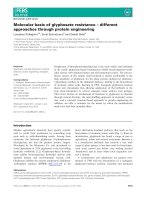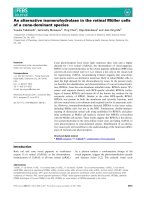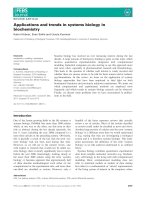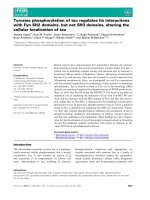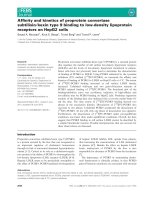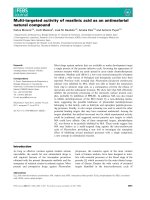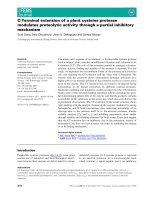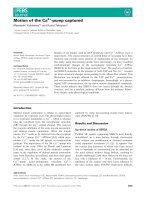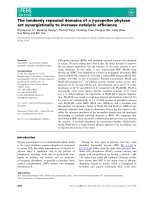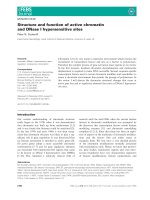Tài liệu Báo cáo khoa học: "Sequential Conditional Generalized Iterative Scaling" pdf
Bạn đang xem bản rút gọn của tài liệu. Xem và tải ngay bản đầy đủ của tài liệu tại đây (87.99 KB, 8 trang )
Sequential Conditional Generalized Iterative Scaling
Joshua Goodman
Microsoft Research
One Microsoft Way
Redmond, WA 98052
Abstract
We describe a speedupfortrainingconditionalmaxi-
mumentropymodels. Thealgorithmis asimplevari-
ation onGeneralizedIterative Scaling, but converges
roughly an order of magnitude faster, depending on
the number of constraints, andthe way speed is mea-
sured. Rather than attempting to train all model pa-
rameters simultaneously, the algorithm trains them
sequentially. The algorithm is easy to implement,
typically uses only slightly more memory, and will
lead to improvements for most maximum entropy
problems.
1 Introduction
Conditional Maximum Entropy models have been
used for a variety of natural language tasks, includ-
ing Language Modeling (Rosenfeld, 1994), part-
of-speech tagging, prepositional phrase attachment,
and parsing (Ratnaparkhi, 1998), word selection for
machine translation (Berger et al., 1996), and find-
ing sentence boundaries (Reynar and Ratnaparkhi,
1997). Unfortunately, although maximum entropy
(maxent) models can be applied very generally, the
typical training algorithm for maxent, Generalized
Iterative Scaling (GIS) (Darroch andRatcliff, 1972),
can be extremely slow. We have personally used up
to a month of computer time to train a single model.
There have been several attempts to speed up max-
ent training (Della Pietra et al., 1997; Wu and Khu-
danpur, 2000; Goodman, 2001). However, as we
describe later, each of these has suffered from appli-
cability toa limited number ofapplications. Darroch
and Ratcliff (1972) describe GIS for joint probabil-
ities, and mention a fast variation, which appears to
have been missed by the conditional maxent com-
munity. We show that this fast variation can also
be used for conditional probabilities, and that it is
useful for a larger range of problems than traditional
speedup techniques. It achieves good speedups for
all but the simplest models, andspeedups ofan order
of magnitude or more for typical problems. It has
only one disadvantage: when there are many possi-
ble outputvalues, the memory needed is prohibitive.
By combining this technique with another speedup
technique (Goodman, 2001), this disadvantage can
be eliminated.
Conditional maxent models are of the form
P (y|
x)=
exp
i
λ
i
f
i
(x, y)
y
exp
i
λ
i
f
i
(x, y
)
(1)
where
x is an input vector, y is an output, the f
i
are
the so-called indicator functions or feature values
that are true if a particular property of
x, y is true,
and λ
i
is a weight for the indicator f
i
. For instance,
if trying to do word sense disambiguation for the
word “bank”,
x would be the context around an oc-
currence of the word; y would be a particular sense,
e.g. financial or river; f
i
(x, y) could be 1 if the con-
text includes the word “money” and y isthefinancial
sense; and λ
i
would be a large positive number.
Maxent models have several valuable proper-
ties. The most important is constraint satisfaction.
Foragivenf
i
, we can count how many times f
i
was observed in the training data, observed[i]=
j
f
i
(x
j
,y
j
). For a model P
λ
with parameters
λ, we can see how many times the model pre-
dicts that f
i
would be expected: expected[i]=
j,y
P
λ
(y|x
j
)f
i
(x
j
,y). Maxent models have the
property that expected[i]=observed[i] for all i.
These equalities are called constraints. An addi-
tional propertyis that, of models inthe form ofEqua-
tion 1, the maxent model maximizes the probability
of thetrainingdata. Yet another propertyis that max-
ent models are as close as possible to the uniform
distribution, subject to constraint satisfaction.
Maximum entropy models are most commonly
learned using GIS, which is actually a very simple
algorithm. At each iteration, a step is taken in a di-
rection that increases the likelihood of the training
Computational Linguistics (ACL), Philadelphia, July 2002, pp. 9-16.
Proceedings of the 40th Annual Meeting of the Association for
data. The step size is guaranteed to be not too large
and not too small: the likelihood of the training data
increases at each iteration and eventually converges
to the global optimum. Unfortunately, this guaran-
tee comes at a price: GIS takes a step size inversely
proportional to the maximum number of active con-
straints. Maxent models are interesting precisely be-
causeof theirabilitytocombinemanydifferentkinds
of information, so this weakness of GIS means that
maxent models are slowto learn precisely when they
are most useful.
We will describe a variation on GIS that works
much faster. Rather than learning all parameters of
the model simultaneously, we learn them sequen-
tially: one, then the next, etc., and then back to the
beginning. Thenewalgorithm convergestothe same
point as the original one. This sequential learning
would not lead to much, if any, improvement, ex-
cept that we also show how to cache subcomputa-
tions. The combination leads to improvements of an
order of magnitude or more.
2 Algorithms
We begin by describing the classic GIS algorithm.
Recall that GIS converges towards a model in
which, for each f
i
, expected[i]=observed[i].
Whenever they are not equal, we can move
them closer. One simple idea is to just add
log observ ed[i]/expected[i] to λ
i
. The problem
with this is that it ignores the interaction with other
λs. If updates to otherλs made on the same iteration
of GIS have a similar effect, we could easily go too
far, and even make things worse. GIS introduces a
slowing factor, f
#
, equal to the largest total value of
f
i
: f
#
= max
j,y
i
f
i
(x
j
,y). Next, GIS computes
an update:
δ
i
=
log observed[i]/expected[i]
f
#
(2)
We thenadd δ
i
toλ
i
. Thisupdate provablyconverges
to the global optimum. GIS for joint models was
givenbyDarrochandRatcliff(1972); theconditional
version is due to Brown et al. (Unpublished), as
described by Rosenfeld (1994).
In practice, we use the pseudocode of Figure 1.
1
We will write I for the number of training instances,
1
Many published versions of the GIS algorithm require in-
clusion of a “slack” indicator function so that the same number
of constraints always applies. In practice it is only necessary
that the total of the indicator functions be bounded by f
#
, not
necessarily equal to it. Alternatively, one can see this as includ-
ing the slack indicator, but fixing the corresponding λ to 0, and
expected[0 F]=0
for each training instance j
for each output y
s[j, y]:=0
for each i such that f
i
(x
j
,y) =0
s[j, y]+= λ
i
× f
i
(x
j
,y)
z :=
y
e
s[j,y]
for each output y
for each i such that f
i
(x
j
,y) =0
expected[i]+= f
i
(x
j
,y) × e
s[j,y]
/z
for each i
δ
i
=
1
f
#
log
observed
[i]
expected[i]
λ
i
+= δ
i
Figure1: OneIterationofGeneralizedIterativeScal-
ing (GIS)
and F for number of indicator functions; we use Y
for the number of output classes (values for y). We
assume that we keep a datastructure listing, for each
training instance
x
j
and each value y, the i such that
f
i
(x
j
,y) =0.
Now we can describe our variation on GIS. Basi-
cally, instead of updating all λ’s simultaneously, we
will loop over each indicator function, and compute
an update for that indicator function, in turn. In par-
ticular, the first change we make is that we exchange
the outer loops over training instances and indicator
functions. Notice that in order to do this efficiently,
we also need to rearrange our data structures: while
we previously assumed that the training data was
stored as a sparse matrix of indicator functions with
non-zero values for each instance, we now assume
that the data is stored as a sparse matrix of instances
with non-zero values for each indicator. The size of
the two matrices is obviously the same.
The next change we make is to update each λ
i
near the inner loop, immediately after expected[i] is
computed, rather than after expected values for all
features have been computed. If we update the fea-
tures one at a time, then the meaning of f
#
changes.
In the original version of GIS, f
#
is the largest total
of all features. However, f
#
only needs to be the
largest total of all the features being updated, and in
not updating it, so that it can be ommitted from any equations;
the proofs that GIS improves at each iteration and that there is
a global optimum still hold.
z[1 I]=Y
s[1 I, 1 Y ]=0
for each feature f
i
expected =0
for each output y
for each instance j such that f
i
(x
j
,y) =0
expected += f
i
(x
j
,y) × e
s[j,y]
/z[j]
δ
i
=
1
max
j,y
f
i
(x
j
,y)
log
observed
[i]
expected[i]
λ
i
+= δ
i
for each output y
for each instance j such that f
i
(x
j
,y) =0
z[j] −= e
s[j,y]
s[j, y]+= δ
i
z[j]+= e
s[j,y]
Figure 2: One Iteration of Sequential Conditional
Generalized Iterative Scaling (SCGIS)
this case, there is only one such feature. Thus, in-
stead of f
#
, we use max
j,y
f
i
(x
j
,y). In many max-
ent applications, the f
i
take on only the values 0 or
1, and thus, typically, max
j,y
f
i
(x
j
,y)=1. There-
fore, instead of slowing by a factor of f
#
, there may
be no slowing at all!
We makeonelast change inorderto get a speedup.
Rather than recompute for each instance j and each
output y, s[j, y]=
i
λ
i
× f
i
(x
j
,y), and the corre-
sponding normalizing factors z =
y
e
s[j,y]
we in-
stead keep these arrays computed as invariants, and
incrementally update them whenever a λ
i
changes.
With this important change, we nowget a substantial
speedup. The code for this transformed algorithm is
given in Figure 2.
The space of models in the form of Equation 1 is
convex, with a single global optimum. Thus, GIS
and SCGIS are guaranteed to converge towards the
same point. For convergence proofs, see Darroch
and Ratcliff (1972), who prove convergence of the
algorithm for joint models.
2.1 Time and Space
In this section, we analyze the time and space re-
quirements for SCGIS compared to GIS. The space
results depend on Y, the number of output classes.
When Y is small, SCGIS requires only a small
amount more space than GIS.Note that in Section 3,
we describe a technique that, when there are many
output classes, uses clustering to get both a speedup
and to reduce the number ofoutputs, thus alleviating
the space issues.
Typically for GIS, the training data is stored as
a sparse matrix of size T of all non-zero indicator
functionsforeachinstancej andoutputy. The trans-
posed matrix used by SCGIS is the same size T .
In order to make the relationship between GIS
and SCGIS clearer, the algorithms in Figures 1 and
2 are given with some wasted space. For instance,
the matrix s[j, y ] of sums of λs only needs to be
a simple array s[y] for GIS, but we wrote it as a
matrix so that it would have the same meaning in
both algorithms. In the space and time analyses, we
will assume that such space-wasting techniques are
optimized out before coding.
Now we can analyze the space and time for GIS.
GIS requires thetraining matrix, ofsize T , theλs, of
size F , as well as the expected and observed arrays,
which are also size F . Thus, GIS requires space
O(T + F ). Since T must be at least as large as F
(we can eliminate any indicator functions that don’t
appear in the training data), this is O(T).
SCGIS is potentially somewhat larger. SCGIS
also needs to store the training data, albeitin adiffer-
ent form, but one that is also of size T. In particular,
the matrix is interchanged so that its outermost index
is over indicator functions, instead of training data.
SCGIS also needs the observed and λ arrays, both
of size F , and the array z[j] of size I, and, more im-
portantly, the full array s[j, y], which is of size IY .
In many problems, Y is small – often2–andIY is
negligible, but in problems like language modeling,
Y can be very large (60,000 or more). The overall
space for SCGIS, O(T +IY ), is essentially the same
as for GIS when Y is small, but much larger when
Y is large – but see the optimization described in
Section 3.
Now, consider the time for each algorithm to ex-
ecute one iteration. Assume that for every instance
and output there is at least one non-zero indicator
function, which is true in practice. Notice that for
GIS, the top loops end up iterating over all non-zero
indicator functions, foreachoutput, for each training
instance. In other words, they examine every entry
in the training matrix T once, and thus require time
T . The bottom loops simply require time F , which
is smaller than T . Thus, GIS requires time O(T ).
For SCGIS, the top loops are also over each non-
zero entry in the training data, which takes time
O(T). The bottom loops also require time O(T ).
Thus, one iteration of SCGIS takes about as long
as one iteration of GIS, and in practice in our im-
plementation, each SCGIS iteration takes about 1.3
times as long as each GIS iteration. The speedup
in SCGIS comes from the step size: the update in
GIS is slowed by f
#
, while the update in SCGIS is
not. Thus, we expect SCGIS to converge by up to a
factor of f
#
faster. For many applications, f
#
can
be large.
The speedup from the larger step size is difficult
to analyze rigorously, and it may not be obvious
whether the speedup we in fact observe is actually
due to the f
#
improvement or to the caching. Note
that without the caching, each iteration of SCGIS
would be O(f#) times slower than an iteration of
GIS; the caching is certainly a key component. But
with the caching, each iteration of SCGIS is still
marginally slower than GIS (bya small constant fac-
tor). In Section 4, wein fact empirically observe that
fewer iterations are required to achieve a given level
of convergence, and this reduction is very roughly
proportional to f#. Thus, the speedup does appear
to be because of the larger step size. However, the
exact speedup from the step size depends on many
factors, including how correlated features are, and
the order in which they are trained.
Although we are not aware of any problems where
maxent training data does not fit in main memory,
and yet the model can be learned in reasonable time,
it is comforting that SCGIS, like GIS, requires se-
quential, notrandom, access to the training data. So,
if one wanted to train a model using a large amount
of data on disk or tape, this could still be done with
reasonable efficiency, as long as the s and z arrays,
for which we need random access, fit in main mem-
ory.
All of these analyses have assumed that the train-
ing data is stored as a precomputed sparse matrix of
the non-zero values for f
i
for each training instance
for each output. In some applications, such as lan-
guage modeling, this is not the case; instead, the
f
i
are computed on the fly. However, with a bit of
thought, those data structuresalsocan be rearranged.
Chen and Rosenfeld (1999) describe a technique
for smoothing maximum entropy that is the best cur-
rently known. Maximum entropy models are natu-
rally maximally smooth, in the sense that they are
as close as possible to uniform, subject to satisfy-
ing the constraints. However, in practice, there may
be enough constraints that the models are not nearly
smooth enough – they overfit the training data. Chen
and Rosenfeld describeatechnique whereby a Gaus-
sian prior onthe parameters is assumed. The models
no longer satisfy the constraints exactly, but work
much better on test data. In particular, instead of
attempting to maximize the probability of the train-
ing data, theymaximizea slightly different objective
function, theprobabilityofthetraining datatimesthe
prior probability of the model:
arg max
λ
J
j=1
P
λ
(y
j
|x
j
)P (λ) (3)
where P (
λ)=
I
i=1
1
√
2πσ
e
−
λ
2
i
2σ
2
. In other words,
the probability of the λs is a simple normal distribu-
tion with 0 mean, and a standard deviation of σ.
Chen and Rosenfeld describe a modified update
rule in which to find the updates, one solves for δ
i
in
observed[i]=expected[i] × e
δ
i
f
#
+
λ
i
+ δ
i
σ
2
SCGIS can be modified in a similar way to use an
update rule in which one solves for δ
i
in
observed[i]=expected[i]×e
δ
i
max
j,y
f
i
(x
j
,y)
+
λ
i
+ δ
i
σ
2
3 Previous Work
Although sequentialupdating wasdescribed for joint
probabilities in the original paper on GIS by Darroch
and Ratcliff (1972), GIS with sequential updating
for conditional models appears previously unknown.
Note that in the NLP community, almost all max-
ent models have used conditional models (which are
typically far more efficient to learn), and none to our
knowledge has used this speedup.
2
There appear to be two main reasons this speedup
has not been used before for conditional models.
One issue is that for joint models, it turns out to be
morenaturaltocomputethesumss[
x], whileforcon-
ditional models, it is more natural to compute the λs
andnotstore thesumss. Storings isessential forour
speedup. Also, one of the first and best known uses
of conditional maxent models is for language mod-
eling (Rosenfeld, 1994), wherethe number of output
classesis thevocabularysize, typically5,000-60,000
words. For such applications, the array s[j, y] would
be of a size at least 5000 times the number of train-
ing instances: clearly impractical (but see below for
2
Berger et al. (1996) use an algorithm that might appear
sequential, butanexaminationofthedefinitionoff
#
andrelated
work shows that it is not.
a recently discovered trick). Thus, it is unsurprising
that this speedup was forgotten.
There have been several previous attempts to
speed up maxent modeling. Best known is the work
of Della Pietra et al. (1997), the Improved Iterative
Scaling (IIS) algorithm. Instead of treating f
#
as a
constant, we can treat it as a function of
x
j
and y.In
particular, let f
#
(x, y)=
i
f
i
(x, y) Then, solve
numerically for δ
i
in the equation
observed[i]= (4)
j,y
P
λ
(y|x
j
) × f
i
(x
j
,y) × exp(δ
i
f
#
(x
j
,y))
Notice that in the special case where f
#
(x, y) is
a constant f
#
, Equation 4 reduces to Equation 2.
However, for training instances where f
#
(x
j
,y) <
f
#
, the IIS update can take a proportionately larger
step. Thus, IIS canlead to speedupswhen f
#
(x
j
,y)
is substantially less than f
#
. It is, however, hard to
think of applications where this difference is typi-
cally large. We only know of one limited experiment
comparing IIS to GIS (Lafferty, 1995). That experi-
mentshowedroughly afactorof2 speedup. Itshould
be noted that compared to GIS, IIS is much harder
to implement efficiently. When solving Equation 4,
one uses an algorithm such as Newton’s method that
repeatedly evaluates the function. Either one must
repeatedlycyclethrough thetrainingdatatocompute
the right hand side of this equation, or one must use
tricks such as bucketing by the values of f
#
(x
j
,y).
The first option is inefficient and the second adds
considerably to the complexity of the algorithm.
Note that IIS and SCGIS can be combined by us-
ing an update rule where one solves for
observed[i]= (5)
j,y
P
λ
(x
j
,y) × f
i
(x
j
,y) × exp(δ
i
f
i
(x
j
,y))
For many model types, the f
i
take only the values 1
or 0. In this case, Equation 5 reduces to the normal
SCGIS update.
Brown (1959) describes Iterative Scaling (IS), ap-
plied to joint probabilities, and Jelinek (1997, page
235) shows how to applyIS toconditional probabili-
ties. For binary-valued features, without thecaching
trick, SCGIS is the same as the algorithm described
by Jelinek. The advantage of SCGIS over IS is the
caching – without which there is no speedup – and
because it is a variation on GIS, it can be applied to
non-binary valued features. Also, with SCGIS, it is
clear how to apply other improvements such as the
smoothing technique ofChen and Rosenfeld (1999).
Several techniques have been developed specif-
ically for speeding up conditional maxent models,
especially when Y is large, such as language mod-
els, andspace precludesa fulldiscussion here. These
techniques include unigram caching, cluster expan-
sion (Lafferty et al., 2001; Wu and Khudanpur,
2000), and word clustering (Goodman, 2001). Of
these, the best appears to be word clustering, which
leads to up to a factor of 35 speedup, and which
has an additional advantage: it allows the SCGIS
speedup to be used when there are a large number of
outputs.
The word clustering speedup (which can be ap-
plied to almost any problem with many outputs, not
justwords)worksas follows. Notice thatin bothGIS
and in SCGIS, there are keyloopsoveralloutputs, y.
Even with certain optimizations that can be applied,
the length of these loops will still be bounded by, and
often be proportional to, the number of outputs. We
therefore change from a model of the form P (y|
x)
to modeling P (cluster(y)|
x) × P (y|x, cluster(y)).
Consider a language model in which y is a word,
x
representsthewordsprecedingy, andthevocabulary
size is10,000 words. Thenfor amodelP (y|
x), there
are 10,000 outputs. On the other hand, if we create
100 word clusters, each with 100 words per clus-
ter, then for a model P (cluster(y)|
x), there are 100
outputs, and for a model P (y|
x, cluster(y)) thereare
also100outputs. Thus, insteadoftrainingonemodel
withatimeproportionalto10,000, wetraintwomod-
els, each with time proportional to 100. Thus, in this
example, there isa50 times speedup. Inpractice, the
speedups are not quite so large, but we do achieve
speedups of upto a factor of 35. Although the model
form learned is not exactly the same as the original
model, theperplexityoftheformusingtwomodels is
actually marginally lower (better) than the perplex-
ity of the form using a single model, so there does
not seem to be any disadvantage to using it.
The word clustering technique can be extended to
use multiple levels. For instance, by putting words
into superclusters, such as their part of speech, and
clusters, such as semantically similar words of a
given part of speech, one could use a three level
model. In fact, the technique can be extended to
up to log
2
Y levels with two outputs per level, mean-
ing that the space requirements are proportional to 2
instead of to the original Y . Since SCGIS works
by increasing the step size, and the cluster-based
speedup works by increasing the speed of the in-
ner loop (whchi SCGIS shares), we expect that the
two techniques would complement each other well,
and that the speedups would be nearly multiplica-
tive. Very preliminary language modeling experi-
ments are consistent with this analysis.
There has been interesting recent unpublished
work by Minka (2001). While this work is very
preliminary, and the experimental setting somewhat
unrealistic (dense features artificiallygenerated), es-
pecially for many natural language tasks, the results
are dramatic enough to be worth noting. In particu-
lar, Minka foundthat a version of conjugategradient
descent worked extremely well – much faster than
GIS. If the problem domainresembles Minka’s, then
conjugate gradient descent and related techniques
are well worth trying, and it would be interesting to
try these techniques for more realistic tasks.
SCGIS turns out to be related to boosting. As
shown by Collins et al. (2002), boosting is in
some ways a sequential version of maxent. The
single largest difference between our algorithm and
Collins’is that we update each featureinorder, while
Collins’ algorithms select a (possibly new) feature
to update. That algorithm also require more storage
than our algorithm when data is sparse: fast imple-
mentations require storage of both the training data
matrix (to compute which feature to update) and the
transpose of the training data matrix (to perform the
update efficiently.)
4 Experimental Results
In this section, we give experimental results, show-
ing that SCGIS converges up to an order of magni-
tude faster thanGIS, or more, dependingon the num-
ber of non-zero indicator functions, and the method
of measuring performance.
There are at least three ways in which one could
measure performance of a maxent model: the ob-
jective function optimized by GIS/SCGIS; the en-
tropy on test data; and the percent correct on test
data. The objective function for both SCGIS and
GIS when smoothing is Equation 3: the probabil-
ity of the training data times the probability of the
model. The most interesting measure, the percent
correct on test data, tends to be noisy.
For a test corpus, we chose to use exactly the same
training, test, problems, and feature sets used by
BankoandBrill(2001). These problemsconsistedof
trying to guess which of two confusable words, e.g.
“their” or “there”, a user intended. Banko and Brill
chose this data to be representative of typical ma-
chine learning problems, and, by trying it across data
sizes and different pairs of words, it exhibits a good
deal of different behaviors. Banko and Brill used
a standard set of features, including words within a
window of 2, part-of-speech tags within a window of
2, pairs of word or tag features, and whether or not
a given word occurred within a window of 9. Alto-
gether, they had55 feature types. That is, there were
many thousands of features in the model (depending
on the exact model), but at most 55 could be “true”
for a given training or test instance.
We examine the performance of SCGIS versus
GIS across three different axes. The most important
variable is the number of features. In addition totry-
ing Bankoand Brill’s55 featuretypes, wetried using
feature sets with 5 feature types (words withinawin-
dow of 2, plus the “unigram” feature) and 15 feature
types (words within a window of 2, tags within a
window of 2, the unigram, and pairs ofwords within
a window of 2). We also tried not using smoothing,
and we tried varying the training data size.
In Table 1, we present a “typical” configuration,
using 55 featuretypes, and 10millionwords of train-
ing, and smoothing with a Gaussian prior. The first
two columns show the different confusable words.
Each column shows the ratio of how much longer
(in terms of elapsed time) it takes GIS to achieve the
same results as 10 iterations of SCGIS. An “XXX”
denotes a case in which GIS did not achieve the
performance level of SCGIS within 1000 iterations.
(XXXs were not included in averages.)
3
The “ob-
jec” column shows the ratio of time to achieve the
same value of the objective function (Equation 3);
the “ent” column show the ratio of time to achieve
the same test entropy; and the “cor” column shows
the ratio of time to achieve the same test error rate.
For all three measurements, the ratio can be up to a
factor of 30, though the average is somewhat lower,
and in two cases, GIS converged faster.
In Table 2 we repeat the experiment, but with-
out smoothing. On the objective function – which
with no smoothing is just the training entropy – the
increase from SCGIS is even larger. On the other
3
On a 1.7 GHz Pentium IV with 10,000,000 words train-
ing, and 5 feature types it took between .006 and .24 seconds
per iteration of SCGIS, and between .004 and .18 seconds for
GIS. With 55 feature types, it took between .05 and 1.7 sec-
onds for SCGIS and between .03 and 1.2 seconds for GIS. Note
that many experiments use much larger datasets or many more
feature types; run time scales linearly with training data size.
objec ent
cor
accept except 31.3 38.9 32.3
affect effect 27.8 10.7 6.4
among between 30.9 1.9 XXX
its it’s
26.8 18.5 11.1
peace piece 33.4 0.3 XXX
principal principle 24.1 XXX 0.2
then than 23.4 37.4 24.4
their there 17.3 31.3 6.1
weather whether 21.3 XXX 8.7
your you’re 36.8 9.7 19.1
Average 27.3 18.6 13.5
Table 1: Baseline: standard feature types (55), 10
million words, smoothed
objec ent cor
accept except 39.3 4.8 7.5
affect effect 46.4 5.2 5.1
among between 48.7 4.5 2.5
its it’s 47.0 3.2 1.4
peace piece 46.0 0.6 XXX
principal principle 43.9 5.7 0.7
then
than 48.7 5.6 1.0
their there 46.8 8.7 0.6
weather whether
44.7 6.7 2.1
your you’re 49.0 2.0 29.6
Average 46.1 4.7 5.6
Table 2: Same as baseline, except no smoothing
criteria – test entropy and percentage correct – the
increase from SCGIS is smaller than it was with
smoothing, but still consistently large.
In Tables 3 and 4, we show results with small and
medium feature sets. As can be seen, the speedups
with smaller features sets (5 feature types) are less
than the speedups with the medium sized feature set
(15 feature types), which are smaller than the base-
line speedup with 55 features.
Notice that across all experiments, there were no
cases where GIS converged faster than SCGIS on
the objective function; two cases where it coverged
faster on test data entropy; and 5 cases where it con-
verged faster on test data correctness. The objective
function measure is less noisy than test data entropy,
and test data entropy is less noisy than test data er-
ror rate: the noisier the data, the more chance of
an unexpected result. Thus, one possibility is that
these cases are simply due to noise. Similarly, the
four cases in which GIS never reached the test data
objec ent cor
accept except 6.0 4.8 3.7
affect effect 3.6 3.6 1.0
among between 5.8 1.0 0.7
its it’s 8.7 5.6 3.3
peace piece 25.2 2.9 XXX
principal principle 6.7 18.6 1.0
then than 6.9 6.7 9.6
their there 4.7 4.2 3.6
weather whether 2.2 6.5 7.5
your you’re 7.6 3.4 16.8
Average 7.7
5.7 5.2
Table 3: Small feature set (5 feature types)
objec ent cor
accept except 10.8 10.7 8.3
affect effect 12.4 18.3 6.8
among between 7.7 14.3 9.0
its it’s 7.4 XXX 5.4
peace piece 14.6 4.5 9.4
principal
principle 7.3 XXX 0.0
then than 6.5 13.7 11.0
their there
5.9 11.3 2.8
weather whether 10.5 29.3 13.9
your you’re 13.1 8.1 9.8
Average 9.6 13.8 7.6
Table 4: Medium feature set (15 feature types)
entropy of SCGIS and the four cases in which GIS
never reached the test data error rate of SCGIS might
also be attributable to noise. There is an alternative
explanation that might be worth exploring. On a dif-
ferent data set, 20 newsgroups, we found that early
stopping techniques were helpful, and that GIS and
SCGIS benefited differently depending on the ex-
act settings. It is possible that effects similar to the
smoothing effect of early stopping played a role in
both the XXX cases (in which SCGIS presumably
benefited more from the effects) and in the cases
where GIS beat SCGIS (in which cases GIS pre-
sumablybenefitedmore.) Additional researchwould
be required to determine which explanation – early
stopping or noise – is correct, although we suspect
both explanations apply in some cases.
We also ran experiments that were the same as the
baseline experiment, except changing the training
data sizeto 50 million words and to 1 million words.
We found that the individual speedups were often
different at the different sizes, but did not appear to
be overall higher or lower or qualitatively different.
5 Discussion
There are many reasons that maxent speedups are
useful. First, in applications with active learning
or parameter optimization or feature set selection,
it may be necessary to run many rounds of maxent,
making speed essential. There are other fast algo-
rithms, such as Winnow, available, but in our ex-
perience, there are some problems where smoothed
maxent models are better classifiers than Winnow.
Furthermore, many other fast classification algo-
rithms, including Winnow, do not output probabil-
ities, which are useful for precision/recall curves,
or when there is a non-equal tradeoff between false
positives and false negatives, or when the output of
the classifier is used as input to other models. Fi-
nally, there are many applications of maxent where
huge amounts of data are available, such as for lan-
guage modeling. Unfortunately, it has previously
been very difficult to use maxent models for these
types of experiments. For instance, in one language
modeling experiment we performed, it took a month
to learn a single model. Clearly, for models of this
type, any speedup will be very helpful.
Overall, we expect this technique to be widely
used. It leads to very significant speedups – up to an
order of magnitude or more. It is very easy to imple-
ment – other than the need to transpose the training
data matrix, and store an extra array, it is no more
complex than standard GIS. It can be easily applied
to any model type, although it leads to the largest
speedups on models with more feature types. Since
models with many interacting features are the type
for which maxent models are most interesting, this
is typical. It requires very few additional resources:
unless there are a large number of output classes, it
uses about asmuch space as standard GIS, andwhen
there are a large number of output classes, it can
be combined with our clustering speedup technique
(Goodman, 2001) to get both additional speedups,
and to reduce the space requirements. Thus, there
appear to be no real impediments to its use, and it
leads to large, broadly applicable gains.
Acknowledgements
Thanks to Ciprian Chelba, Stan Chen, Chris Meek,
and the anonymous reviewers for useful comments.
References
M. Banko and E. Brill. 2001. Mitigating the paucity
of data problem. In HLT.
Adam L. Berger, Stephen A. Della Pietra, and Vin-
cent J. Della Pietra. 1996. A maximum entropy
approach to natural language processing. Compu-
tational Linguistics, 22(1):39–71.
P. Brown, S. DellaPietra, V. DellaPietra, R. Mercer,
A. Nadas, and S. Roukos. Unpublished. Transla-
tion models using learned features and a general-
ized Csiszar algorithm. IBM research report.
D. Brown. 1959. A note on approximations to prob-
ability distributions. Information and Control,
2:386–392.
S.F. Chen and R. Rosenfeld. 1999. A gaussian prior
for smoothing maximum entropy models. Tech-
nicalReportCMU-CS-99-108,ComputerScience
Department, Carnegie Mellon University.
Michael Collins, Robert E. Schapire, and Yoram
Singer. 2002. Logistic regression, adaboost and
bregman distances. Machine Learning, 48.
J.N. Darroch and D. Ratcliff. 1972. Generalized it-
erative scaling for log-linear models. The Annals
of Mathematical Statistics, 43:1470–1480.
Stephen Della Pietra, Vincent Della Pietra, and John
Lafferty. 1997. Inducing features of random
fields. IEEETransactionsonPatternAnalysisand
Machine Intelligence, 19(4):380–393, April.
Joshua Goodman. 2001. Classes for fast maximum
entropy training. In ICASSP 2001.
Frederick Jelinek. 1997. Statistical Methods for
Speech Recognition. MIT Press.
J.Lafferty, F. Pereira, andA. McCallum. 2001. Con-
ditional random fields: Probabilistic models for
segmenting and labeling sequence data. In ICML.
John Lafferty. 1995. Gibbs-markov models. In
Computing Science and Statistics: Proceedings
of the 27th Symposium on the Interface.
Thomas Minka. 2001. Algorithms for maximum-
likelihood logistic regression. Available from
/>˜tpminka/papers/learning.html.
Adwait Ratnaparkhi. 1998. Maximum Entropy
Models for Natural Language Ambiguity Resolu-
tion. Ph.D. thesis, University of Pennsylvania.
J. Reynar and A. Ratnaparkhi. 1997. A maximum
entropy approach to identifying sentence bound-
aries. In ANLP.
Ronald Rosenfeld. 1994. Adaptive Statistical Lan-
guage Modeling: A Maximum Entropy Approach.
Ph.D. thesis, Carnegie Mellon University, April.
J. Wu and S. Khudanpur. 2000. Efficient training
methods for maximum entropy language model-
ing. In ICSLP, volume 3, pages 114–117.
